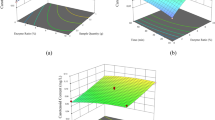Abstract
Laboratory investigations into the possibility of using local Nigerian clays in refining the Nigerian crude palm oil revealed that the Okija clay may possess some potential as an adsorptive cleanser in the refining process. Activated bentonite was used as the standard clay of comparison, and the performance of two local natural clays, leached with various concentrations of sulfuric acid, was evaluated for their use as alternative adsorptive cleansers in refining Nigerian crude palm oil. Measurements of peroxide values, para-anisidine values, carotene content and stabilities of the oils using the active oxygen method were used in assessing the relative performance of the clays.
The clays exhibited similar trend of effects on identical batches of alkali-neutralized palm oil. In one set of experiments poor results were obtained when the degummed and alkali-neutralized palm oil was treated with clays leached with sulfuric acid at concentrations of 1M and 4M. Better results were obtained at acid concentrations of 2M and 3M. Bentonite proved better than Okija clay when the leaching was performed with 2M H2SO4, but both clays had comparable effectiveness when 3M H2SO4 was used for leaching. The Nsu clay gave the least encouraging results. In another series of experiments the results showed that for various dosages of clay, up to 3% by weight of the oil to be refined, the oxidative stability of the processed oil was reasonably good for an oil which was neither deodorized nor treated with antioxidants.
Similar content being viewed by others
References
Wiedermann, L.H.,J. Am. Oil Chem. Soc. 58:158 (1981).
Liew, K.Y., S.H. Tan, F. Morsingh and L.E. Khoo, Ibid.:287 (1985).
Goebel, E.H., Ibid.:199 (1981).
Ames, G.R., W.D. Raymond and J.B. Ward,J. Sci. Food Agric. 4:194 (1960).
Kheok, S.C., and E.E. Lim,J. Am. Oil Chem. Soc. 59:129 (1982).
Maclellan, M.,Ibid. 60:320A (1983).
Official and Tentative Methods of the American Oil Chemists’ Society, 3rd edn., edited by W.E. Link, AOCS, Champaign, IL, 1974, Method Cd 8–53.
Parquot, C.,Standard Methods for the Analysis of Oils, Fats and Derivatives, 6th edn., IUPAC Appl. Chem. Div., Commission on Oils, Fats and Derivatives, 1979.
Young, V.,Chem. and Ind. Sept. 16, 1978, p. 692.
Johansson, G.,Ibid. Nov. 1, 1975, p. 902.
Morgan, D.A., D.B. Shaw, M.J. Sidebottom, T.C. Soon and R.S. Taylor,J. Am. Oil Chem. Soc. 62:292 (1985).
Augustin, M.A., and S.K. Berry Ibid.:105 (1983).
List, G.R., C.D. Evans, K. Warner and B.K. Boundy, Ibid.:17 (1974).
Gray, J.I., Ibid.:539 (1978).
Author information
Authors and Affiliations
About this article
Cite this article
Nkpa, N.N., Arowolo, T.A. & Akpan, H.J. Quality of nigerian palm oil after bleaching with local treated clays. J Am Oil Chem Soc 66, 218–222 (1989). https://doi.org/10.1007/BF02546063
Received:
Accepted:
Issue Date:
DOI: https://doi.org/10.1007/BF02546063




